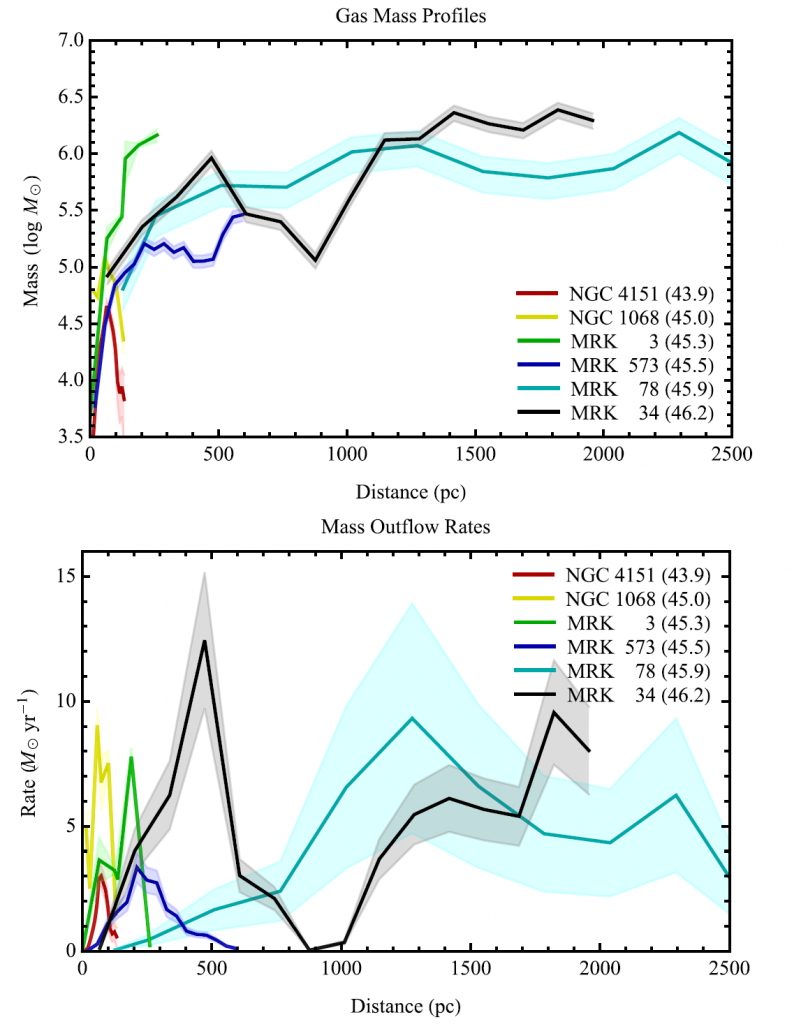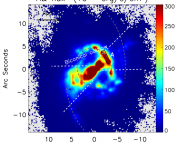Authors: Mitchell Revalski et al.
First Author’s Institution: Space Telescope Science Institute, 3700 San Martin Drive, Baltimore, MD 21218, USA
Status: Accepted to ApJ (open access).
From Earth, the night sky emanates an intangible stillness – akin to a calm ocean. However, beyond this thin veil, distant undertows cave the cosmic sea and energetic waves relentlessly thrash.
Welcome to the Machine
Beyond our terrestrial gaze, a special breed of “active” galaxies populate our universe. Within these dynamic galaxies reside “Active Galactic Nuclei” (AGN) – central supermassive black holes actively accreting matter. These AGN operate like celestial machines, converting gravitational energy into AGN “feedback” (e.g., highly energetic winds, powerful jets, or sweeping outflows that entrain ionized and molecular gas).
Further, while we understand the basic nature of this conversion process, we are still eager to comprehend the fundamental physics of AGN feedback and its role in galaxy evolution.
Resolving the Dilemma
To better constrain the evolution of AGN feedback, studying outflows that extend from the nuclear region of a galaxy to its edges can be extremely valuable for drawing a complete picture. Moreover, spatially resolved imaging and spectroscopy, which provide unique images and spectra for different regions of a galaxy, are vital in this regard! The authors of today’s paper thus leverage spatially resolved data from the Space Telescope Imaging Spectrograph (STIS), Faint Objects Camera, and Wide Field Planetary Camera 2 aboard the Hubble Space Telescope (HST) – in tandem with data from the Dual Imaging Spectrograph (DIS) at the Apache Point Observatory (APO) – to assess outflows in three galaxies that host AGN (Mrk 3, Mrk 78, and NCC 1068; Figure 1).
Kinematics Toolbox
Armed with spatially resolved spectroscopy, the authors fit Gaussian profiles to prominent emission lines in their sample (e.g., [OIII] λ5007 and Hα) that are often used to trace outflows. Using multiple fitting components, they determine the strength (primarily using [OIII] λ5007 flux) and velocity properties (i.e. kinematic components; determined by the [OIII] λ5007 line centroid, width, and height above the continuum) for each galaxy’s outflows.
Figure 1: HST color-composite images of Mrk 3 (top-left), NGC 1068 (top-right), and Mrk 78 (bottom). The image of Mrk 78 has a rectangular inset rectangle, where the solid lines differentiate the locations and slit widths of the observations, with HST STIS (0.2” wide slit) in black and APO DIS (2.0” wide slit) in gray. The HST and APO slits spatially overlap and are truncated at the dashed rectangle for visibility. Bright white-blue emission near the nuclei shows AGN-ionized gas, diffuse white is primarily stellar continuum emission, and the dark lanes and patches are due to dust. The red clumps in NGC 1068 are HII regions created by star formation outside of the nucleus. [Figure 1 in paper]
Figure 2 showcases how the strength of the outflows in each galaxy varies with galactocentric distance (factoring in projection effects). Generally, with Mrk 3 being the exception, they find that the outflows in their sample are clumpy and inhomogeneous. More revealing, though, are the kinematics of the outflows (e.g., the mass outflow rate, kinetic energy, kinetic energy outflow rate, momentum, and momentum outflow rate)! Using the photoionization code CLOUDY, the authors model the gas densities, ionization parameters, elemental abundances, and dust content for the galaxies. These parameters are then used to find the mass of the ionized gas transported along the outflows, which is critical for determining the outflow energetics. Equipped with a shiny kinematics toolbox, the authors can now help us tune our understanding of AGN outflow dynamics!

Figure 2: The spatially-resolved gas mass profiles (top) and mass outflow rates (bottom) for NGC 4151 (Crenshaw et al. 2015), NGC 1068 (this work), Mrk 3 (this work), Mrk 573 (Revalski et al. 2018a), Mrk 78 (this work), and Mrk 34 (Revalski et al. 2018b). The logarithmic bolometric luminosity for each AGN is provided in parentheses. The masses and outflow rates are the quantity in each radial bin, not enclosed totals, and each target has a different bin size. [Figure 11 in Paper]
Assembling the Puzzle
AGN bolometric luminosity measures the total luminosity emitted by an AGN across all wavelengths. It effectively offers direct insight into AGN power and accretion efficiency. Using [OIII] λ5007 luminosity measurements, the authors determine the bolometric luminosity for each galaxy and compare it to the kinematic properties of each galaxy’s outflows (Figure 3).
They uncover that all of the kinematic properties they measure across their sample correlate with AGN bolometric luminosity. In essence, when there is more AGN fuel available, more gas is able to be ionized, which enhances the outflow rates and velocities.
However, when they inspect the outflow kinematics for each galaxy as a function of distance, they find even more intriguing results. For Mrk 78, they detect a steady kinetic energy and momenta profile as a function of galactocentric distance. Comparatively, Mrk 1068 and Mrk 3 profiles peak near the nucleus (i.e. the central 500 pc) before exponentially decaying (Figure 2). This may serve as preliminary evidence for two outflow models, as suggested by other authors: 1) a steady nuclear flow drives AGN outflows and produces kinematic profiles that peak near the galactic center (< 500 pc) before falling off, and 2) outflows can be driven by radiation fields at extended distances beyond the nuclear region, which can sustain outflow kinematic profiles.
Figure 3: The total mass, kinetic energy, and momentum of the outflows (left column), as well as the mass, kinetic energy, and momentum outflow rates (right column) for each AGN as a function of bolometric luminosity, with exact values provided in parentheses. Note, NGC 4151, Mrk 573, and Mrk 34 were analyzed in a previous paper by the author and are provided in this figure for reference. In general, all of the total and peak energetic quantities are positively correlated with increasing AGN bolometric luminosity. [Figure 14 in paper]
Have a Cigar
Today’s paper delivers insight into the fundamental nature of AGN outflows. Using the Hubble Space Telescope and the Apache Point Observatory, the authors analyze an array of emission lines for the galaxies in their sample to determine the morphology of their AGN-driven outflows. They uncover that these outflows are generally inhomogeneous and clumpy. Further, their kinematic analysis reveals that the mass of ionized gas scales with AGN power (i.e. AGN bolometric luminosity) – more AGN fuel leads to more ionized gas that drives more powerful outflows.
Admittedly, intriguing questions still linger regarding AGN outflows; for example, what is the role of a companion galaxy? What are the impacts of outflows on star formation? Nonetheless, today’s paper provides us an essential step in the right direction!
Image Credit: NASA/CXC/SAO; Optical: Rolf Olsen; Infrared: NASA/JPL-Caltech
Editor: Ishan Mishra




